It’s winter in Maryland. In fact, it’s so much winter I shoveled 10 inches of snow off my driveway this morning. Fortunately, I had company. It wasn’t the kind of company that picks up a shovel and helps out, but still, the American robins darting back and forth over my head were still welcome (if surprising and surprisingly quiet) snow day companions.
Become a Member
Make a lasting impact for nature when you join The Nature Conservancy
“You know,” I said to them as I leaned on my shovel to watch about 25 birds flock together in my neighbor’s oak. “I think y’all are a little early—aren’t you supposed to be the first harbingers of spring?”
We’re not even a month past the first day of winter in the northern hemisphere. Spring is definitely not here. So why are the robins? Shouldn’t they be sunning themselves in warmer climes?
The short answer: as long as there’s food, American robins—true to their name Turdus migratorius (“the wandering thrush”)—kind of spend their winters coming and going as they please.
Robin Migration (AKA Robin Wandering)
Robins do migrate—but they don’t necessarily follow a more or less straight line from north to south in the fall, then repeat the journey south to north in the spring. In the fall and winter, when the ground freezes, robins lose access to their meal of choice: worms, insects (adult and larval) and (occasionally) snails. That’s when they turn to their winter diet staple: mostly fruit, mostly berries.
The folks at Journey North, a project tracking robin movements run by the University of Wisconsin-Madison, put it this way, “Some robins retreat all the way to southern Texas and Florida (in fact, some of the largest winter flocks documented by the Christmas Bird Count gather in sunny St. Petersburg, Florida), but others winter as far north as they can find berries. So they have an enormous winter range. Robins do migrate, but it has more to do with food sources than with being faithful to the same places year over year.”
In that way American robins are somewhat akin to teenage boys—they tend to go where the best (or most abundant or most easily accessible) food is, stay until it’s depleted, and then move on.
So as long as there are enough berries and other fruits to sustain them, you may see robins off and on throughout the winter across much of North America.
Forget the birdseed though. Robins’ digestive systems, unlike sparrows or other so-called feeder birds, aren’t built for dealing with seed, and their beaks aren’t built for cracking things open. Robin beaks are built for snapping up worms, catching insects, and plucking berries and other fruits. In the winter, a flock of robins can strip a holly bush with impressive speed and efficiency, and very little—if any—violent robin-on-robin aggression.
Food is also one of the reasons that robins, notoriously territorial and aggressive in breeding season, tend to gather and travel in flocks in the fall and winter. Numbers are good for defense, and also for spotting food—if one robin happens on a holly tree full of bright, ripe berries, the whole flock can partake. And then move on.
The tendency of robins to flock in winter may also be one of the reasons people seem to notice them—birds in large numbers tend to stand out when they’re gathered in leafless trees. (That and the beautiful red breast that is sometimes the only splash of color in a winter landscape that looks practically lunar in relentless shades of February white and gray.)
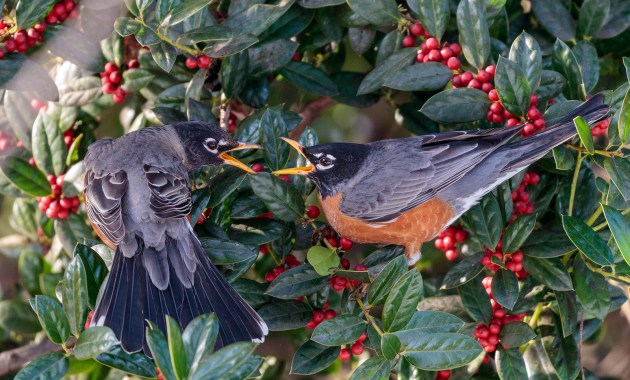
How do Robins Survive the Cold?
Robins are outfitted to survive huge temperature variances. In fact, hot weather seems to stress them more than cold.
If an American robin is healthy, has enough to eat, and is able to main its feathers, the temperature next to its body stays around 104 F—regardless of how cold it is in the world outside. It really is all about those feathers. (And the legs and feet.)
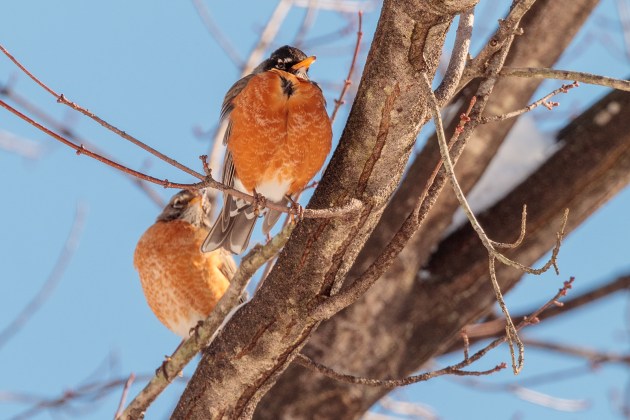
Robins, like most birds, have layers of feathers that perform different functions. When temperatures drop, robins puff the fine, downy feathers closest to their bodies to keep heat in, cold out. The outer feathers act like a kind of overcoat, shedding water and moisture and helping to regulate the bird’s temperature. (It’s an adaptation not limited to robins. Most birds with down feathers fluff them to regulate body heat).
The anatomy of a robin’s (and other bird species) also contributes to their cold adaptations. The bird experts over at the Cornell Lab explain it very well. The simplified version is that “most birds don’t succumb to frostbite because there is so little fluid in the cells of their feet, and their feet are mostly tendons and bones with little muscle or nerve tissue.”
So while blood does flow to their legs and feet, most birds (including robins) benefit from a very fast circulatory system and a “countercurrent heat exchange system.” Because bird legs are thin, the vessels that move blood from the heart to the feet and back again are very close together. That proximity means, per Cornell, “blood flowing back to the body is warmed by blood flowing to the feet. The newly cooled blood in the feet lowers heat loss from the feet, and the warmed blood flowing back into the body prevents the bird from becoming chilled.”
Robins: The Tell-Tale Birds of Spring
If robins are around in winter, why have they always been associated with the beginning of spring in the U.S.? Most likely it has to do with ground thaw, snow melt, and territorial behaviors like singing, worm hunting and nest building. But mostly, it’s the singing.
According to Journey North, which has a fantastic Q+A section I highly recommend for the robin-curious, “the robin’s song remains a reliable indicator that the first wave of spring migration has reached you. This song is one of the first signs that robins are switching from winter behavior to courtship and nesting behaviors associated with spring.”
Robins tend to move north as the ground thaws. The availability of high protein prey, especially worms that emerge with warmer, often wetter weather, is when a robin’s thoughts turn to procreation. And that’s the end of the cooperative fall and winter behaviors.
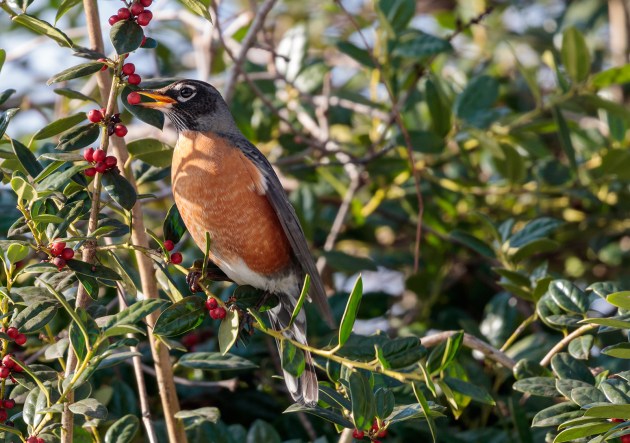
Which is one of the reasons many robins (primarily males) may stay through harsher winters instead of booking it to St. Petersburg: first access to the choicest nesting grounds. Breeding season is when robins also become more visible with mating displays, nest-building and a lot of time on the ground hunting for the tastiest worms. Until then, they’re all about the berries.
You Can Help Robins with Science from Your Own Backyard
Like many species, including other birds, scientists are starting to see some changes in robin behavior that is likely attributable to climate change. One study of American robins migrating to and from Canada’s boreal forest, showed that they’re beginning to journey south on average about 12 days earlier than in past years, or five days earlier per decade since 1994.
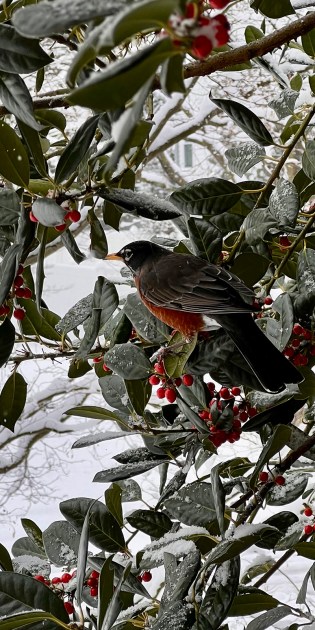
If you want to help scientists studying birds, there are several ways to contribute your observations (not just for robins, but for many of the species you can see outside your windows).
Journey North
You can submit your robin observations directly on the Journey North site (and check out their other migration-related citizen science projects). They also have 2025 maps tracking sightings so you can see where American robins (and other signs of spring) are being observed and follow along (and contribute to) the wanderings of Turdus migratorius.
Cornell Lab of Ornithology
The Cornell Lab has a number of different ways you can contribute to science for birds. Your sightings tracked on eBird (free) contribute to worldwide data for birding, science, and conservation. Want to know what birds are being seen in your neighborhood, eBird has a feature for that. If you’re new to birding, check out their genius birding ID app, Merlin.
You can also contribute to Project FeederWatch (requires subscription) by counting birds at your feeder from November through April. Your observations help scientists monitor changes in the abundance and distribution of birds, including the influence of changes in habitat, disease, and climate.
And mark your calendars for the 2025 Great Backyard Bird Count (February 14-17). Spend time in your favorite places watching birds—then report them to Cornell! It’s easy to participate, “in as little as 15 minutes notice the birds around you. Identify them, count them, and submit your counts to help scientists better understand and protect birds around the world. You can see the results from 2024 here.
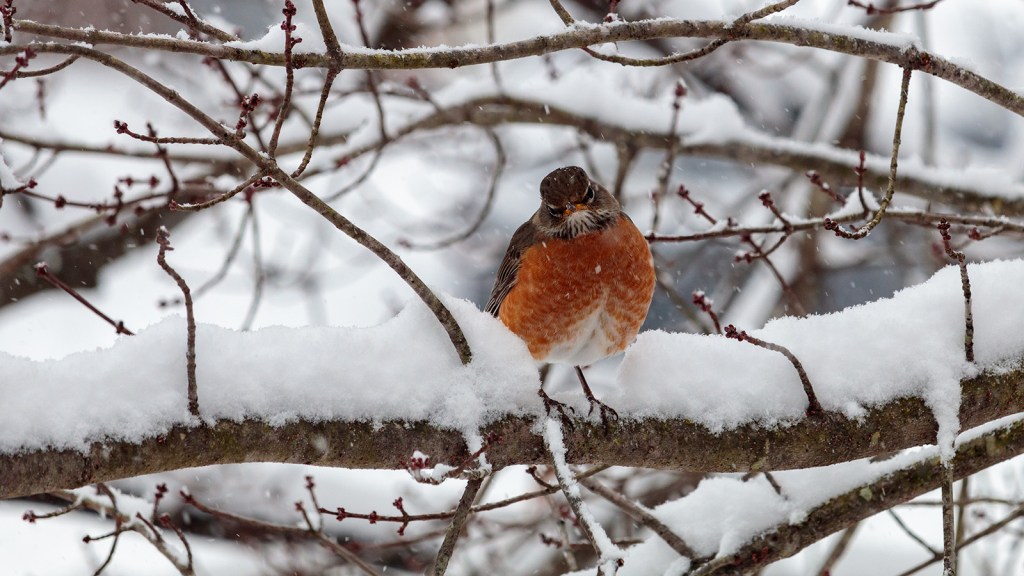



The week of Feb. 14-20 (freezing temperatures) in the Dallas Texas metroplex, I saw 100s of robins in my backyard & in trees. Was amazing!
Thank you, I was thinking I was losing my mind. I love bird watching and I have never seen so many Robins in my life. The joy & blessing is listening to them and seeing so many at one time.
My morning and after noon walks has been such a joy. Can’t wait to see what Spring has in store for me
watching all my bird.
We had a big group of robins in our yard, on a crab tree, in the first week of Feb. They only stayed a short time, then flew west. There must have been 25 or 30 of them. We live in the southern most part of Lower Michigan.
February 22, 2021 saw my first Robin in the Michigan High cranberry bush looking for berries. Sorry, a Group of starlings had cleaned out the white berries in the fall, so very few red berries in the spring. The next day a flock of robins came to that same Bush. Finished up a few red berries at the tips of the branches! What a sight!
Wow, yes we saw a large flock on Valentine’s Day, the coldest day, flying around our back yard here in Madison, Wisconsin. We have a large mulberry tree.
I had a very large flock of robins in my yard and the neighbors’ last week. 02/15-02/19. Do not remember exact day. At least 75 though seemed like much more. Was the worst cold weather in 20 or more years. Daytime temps were 5-10 degrees F with 7-9 inches of snow and ice. Nighttime temps below zero. Have never seen such a large flock before and have lived in Oklahoma all my life. Norman, OK. Hope that information helps your data.
2/24/21 at 5:00 p.m. We saw a flock of about 50 to 60 Robins. They were in our yard and driveway. We live in a rural area about 50 miles northeast of Binghamton,NY. WE have never seen them in February before.
Our backyard is full of Robins right now and it’s such a welcome and wonderful sight to see. We had temperatures last week of 4 degrees and I was so afraid they would be harmed by the extreme cold. We had snow and ice and no way for them to reach the ground. I put saucers of wild bird seed out and they loved it .
They are still here and I love watching them.
At one time a few days ago I counted 53 of them in the yard eating.
We have had Robin’s nests in the same spot every summer for 3-4 years, then not for a few years, then back on again for 3-4 years. Is this the same bird coming back year after year? There are usually eggs in the nest 2-3x each summer.
In Kalamazoo County Michigan I have been seeing a Robin since January. He appears more and more and I find him sitting on my crab apple tree which has quite a bit of fruit left on it even though it’s very near to March. I did put out some raisins some cut up grapes and some apple slices in a platform feeder I haven’t seen him feeding from that yet. I was happy to read in your article that often Robins stay through the winter and I do have a lot of very thick hedges around my home and also a lot of Pines in the area so I do believe this Robin stayed throughout the winter. Thank you for such an excellent article.
We have been having flocks of robins near our home I would love to attract them to our trees to observe and watch them do their thing what are some tips for that besides water? Will seed attract them too
Through your research for this piece, did you learn anything about the Robin’s unusual winter migration into South Texas this season? Observers, such as me, began seeing large numbers of them in regions where they have not been observed in many years. One anecdotal explanation repeated among the birding community suggests that widespread wildfires in the Robin’s usual winter habitat resulted in inadequate food/shelter, forcing the birds to migrate eastward. Does any of this found familiar? I’ll pose this question to Elizabeth Howard as well. Thanks.
I have yet to see a robin in our area. Usually we see nuthatches in Springbank Park, London, but there haven’t been any thisyear. The grandchildren liked to feed them out of their hands. Possiblyit’s because there has been more activity on the pathways because of Covid? Thank you foryourreply if you have any informationI enjoyed your informative article on robins, Thank you.
Two weeks ago I saw so many of them 50 to 100 flying around my neighborhood. Like a game they were flying in circles. Then last week during the snow storm so many of them on the ground i guess looking for food. The must have been males. They are adorable ?.
Hundreds on the west coast of Central Florida right now! Feasting on the berries of the female Brazilian pepper trees.